Comprehensive Analysis of Risk Assessment for NSW Rail Project
VerifiedAdded on 2023/02/01
|15
|4372
|97
Report
AI Summary
This report provides an in-depth analysis of the risk assessment conducted for the NSW regional rail fleet project in Australia. The project aims to replace the aging rail fleet and enhance infrastructure to improve passenger experience. The report begins with an introduction to the project, outlining its objectives which include improved comfort, safety, and accessibility for commuters. It then delves into the project background, highlighting the need for transportation upgrades due to population growth. A comprehensive literature review is presented, defining risk and emphasizing the need for effective risk management frameworks. The report identifies various risk categories, including political, social, construction, financial, design, management, material, site safety, and environmental risks, providing detailed descriptions of each. The analysis includes both qualitative and quantitative risk assessment methodologies. Finally, the report discusses the project's feasibility and concludes with an overall assessment of the identified risks and potential mitigation strategies.

Running head: ANALYSIS OF RISK ASSESSMENT
Analysis of Risk Assessment
Name of the student:
Name of the university:
Author Note:
Analysis of Risk Assessment
Name of the student:
Name of the university:
Author Note:
Paraphrase This Document
Need a fresh take? Get an instant paraphrase of this document with our AI Paraphraser
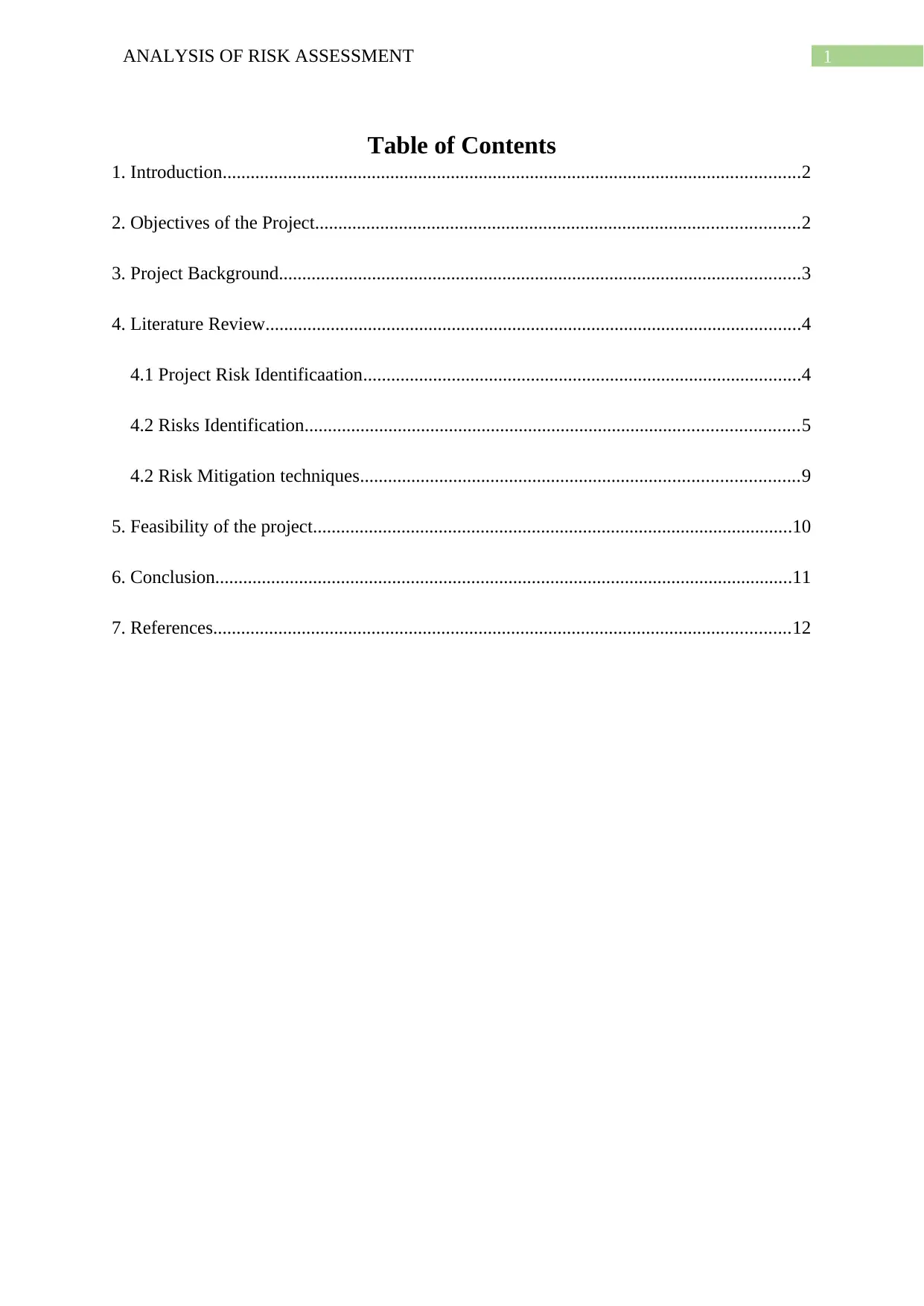
1ANALYSIS OF RISK ASSESSMENT
Table of Contents
1. Introduction............................................................................................................................2
2. Objectives of the Project........................................................................................................2
3. Project Background................................................................................................................3
4. Literature Review...................................................................................................................4
4.1 Project Risk Identificaation..............................................................................................4
4.2 Risks Identification..........................................................................................................5
4.2 Risk Mitigation techniques..............................................................................................9
5. Feasibility of the project.......................................................................................................10
6. Conclusion............................................................................................................................11
7. References............................................................................................................................12
Table of Contents
1. Introduction............................................................................................................................2
2. Objectives of the Project........................................................................................................2
3. Project Background................................................................................................................3
4. Literature Review...................................................................................................................4
4.1 Project Risk Identificaation..............................................................................................4
4.2 Risks Identification..........................................................................................................5
4.2 Risk Mitigation techniques..............................................................................................9
5. Feasibility of the project.......................................................................................................10
6. Conclusion............................................................................................................................11
7. References............................................................................................................................12
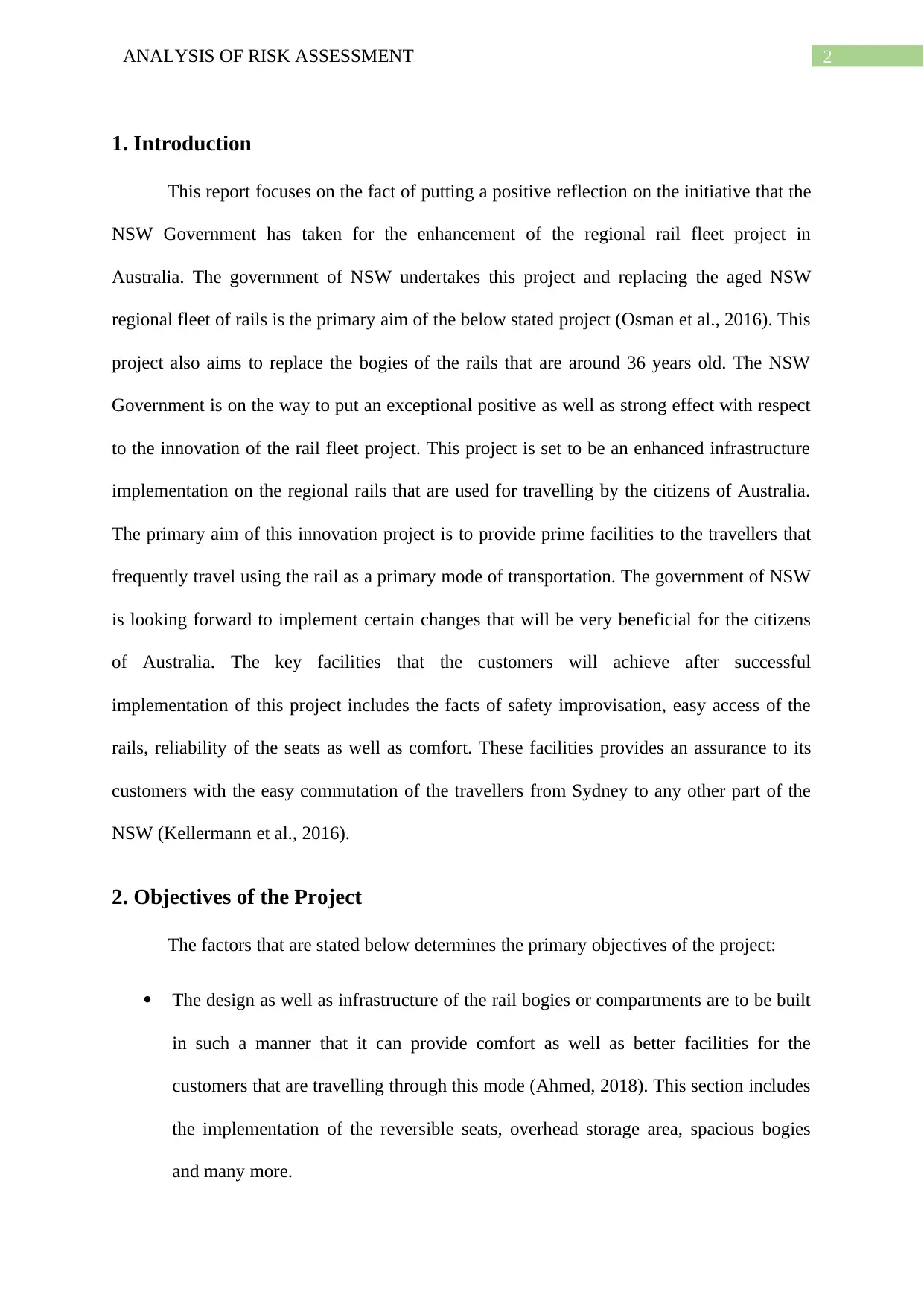
2ANALYSIS OF RISK ASSESSMENT
1. Introduction
This report focuses on the fact of putting a positive reflection on the initiative that the
NSW Government has taken for the enhancement of the regional rail fleet project in
Australia. The government of NSW undertakes this project and replacing the aged NSW
regional fleet of rails is the primary aim of the below stated project (Osman et al., 2016). This
project also aims to replace the bogies of the rails that are around 36 years old. The NSW
Government is on the way to put an exceptional positive as well as strong effect with respect
to the innovation of the rail fleet project. This project is set to be an enhanced infrastructure
implementation on the regional rails that are used for travelling by the citizens of Australia.
The primary aim of this innovation project is to provide prime facilities to the travellers that
frequently travel using the rail as a primary mode of transportation. The government of NSW
is looking forward to implement certain changes that will be very beneficial for the citizens
of Australia. The key facilities that the customers will achieve after successful
implementation of this project includes the facts of safety improvisation, easy access of the
rails, reliability of the seats as well as comfort. These facilities provides an assurance to its
customers with the easy commutation of the travellers from Sydney to any other part of the
NSW (Kellermann et al., 2016).
2. Objectives of the Project
The factors that are stated below determines the primary objectives of the project:
The design as well as infrastructure of the rail bogies or compartments are to be built
in such a manner that it can provide comfort as well as better facilities for the
customers that are travelling through this mode (Ahmed, 2018). This section includes
the implementation of the reversible seats, overhead storage area, spacious bogies
and many more.
1. Introduction
This report focuses on the fact of putting a positive reflection on the initiative that the
NSW Government has taken for the enhancement of the regional rail fleet project in
Australia. The government of NSW undertakes this project and replacing the aged NSW
regional fleet of rails is the primary aim of the below stated project (Osman et al., 2016). This
project also aims to replace the bogies of the rails that are around 36 years old. The NSW
Government is on the way to put an exceptional positive as well as strong effect with respect
to the innovation of the rail fleet project. This project is set to be an enhanced infrastructure
implementation on the regional rails that are used for travelling by the citizens of Australia.
The primary aim of this innovation project is to provide prime facilities to the travellers that
frequently travel using the rail as a primary mode of transportation. The government of NSW
is looking forward to implement certain changes that will be very beneficial for the citizens
of Australia. The key facilities that the customers will achieve after successful
implementation of this project includes the facts of safety improvisation, easy access of the
rails, reliability of the seats as well as comfort. These facilities provides an assurance to its
customers with the easy commutation of the travellers from Sydney to any other part of the
NSW (Kellermann et al., 2016).
2. Objectives of the Project
The factors that are stated below determines the primary objectives of the project:
The design as well as infrastructure of the rail bogies or compartments are to be built
in such a manner that it can provide comfort as well as better facilities for the
customers that are travelling through this mode (Ahmed, 2018). This section includes
the implementation of the reversible seats, overhead storage area, spacious bogies
and many more.
⊘ This is a preview!⊘
Do you want full access?
Subscribe today to unlock all pages.

Trusted by 1+ million students worldwide
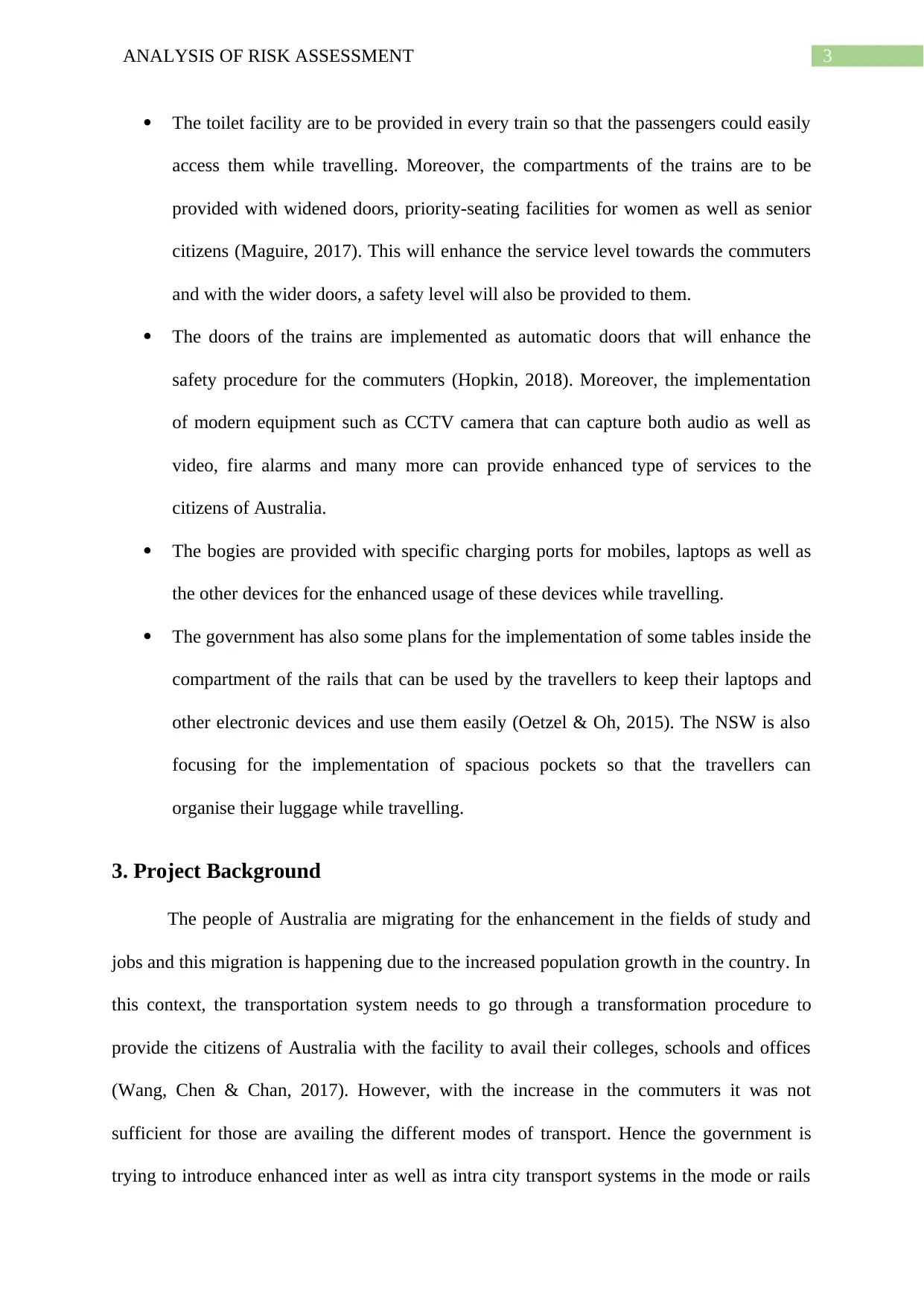
3ANALYSIS OF RISK ASSESSMENT
The toilet facility are to be provided in every train so that the passengers could easily
access them while travelling. Moreover, the compartments of the trains are to be
provided with widened doors, priority-seating facilities for women as well as senior
citizens (Maguire, 2017). This will enhance the service level towards the commuters
and with the wider doors, a safety level will also be provided to them.
The doors of the trains are implemented as automatic doors that will enhance the
safety procedure for the commuters (Hopkin, 2018). Moreover, the implementation
of modern equipment such as CCTV camera that can capture both audio as well as
video, fire alarms and many more can provide enhanced type of services to the
citizens of Australia.
The bogies are provided with specific charging ports for mobiles, laptops as well as
the other devices for the enhanced usage of these devices while travelling.
The government has also some plans for the implementation of some tables inside the
compartment of the rails that can be used by the travellers to keep their laptops and
other electronic devices and use them easily (Oetzel & Oh, 2015). The NSW is also
focusing for the implementation of spacious pockets so that the travellers can
organise their luggage while travelling.
3. Project Background
The people of Australia are migrating for the enhancement in the fields of study and
jobs and this migration is happening due to the increased population growth in the country. In
this context, the transportation system needs to go through a transformation procedure to
provide the citizens of Australia with the facility to avail their colleges, schools and offices
(Wang, Chen & Chan, 2017). However, with the increase in the commuters it was not
sufficient for those are availing the different modes of transport. Hence the government is
trying to introduce enhanced inter as well as intra city transport systems in the mode or rails
The toilet facility are to be provided in every train so that the passengers could easily
access them while travelling. Moreover, the compartments of the trains are to be
provided with widened doors, priority-seating facilities for women as well as senior
citizens (Maguire, 2017). This will enhance the service level towards the commuters
and with the wider doors, a safety level will also be provided to them.
The doors of the trains are implemented as automatic doors that will enhance the
safety procedure for the commuters (Hopkin, 2018). Moreover, the implementation
of modern equipment such as CCTV camera that can capture both audio as well as
video, fire alarms and many more can provide enhanced type of services to the
citizens of Australia.
The bogies are provided with specific charging ports for mobiles, laptops as well as
the other devices for the enhanced usage of these devices while travelling.
The government has also some plans for the implementation of some tables inside the
compartment of the rails that can be used by the travellers to keep their laptops and
other electronic devices and use them easily (Oetzel & Oh, 2015). The NSW is also
focusing for the implementation of spacious pockets so that the travellers can
organise their luggage while travelling.
3. Project Background
The people of Australia are migrating for the enhancement in the fields of study and
jobs and this migration is happening due to the increased population growth in the country. In
this context, the transportation system needs to go through a transformation procedure to
provide the citizens of Australia with the facility to avail their colleges, schools and offices
(Wang, Chen & Chan, 2017). However, with the increase in the commuters it was not
sufficient for those are availing the different modes of transport. Hence the government is
trying to introduce enhanced inter as well as intra city transport systems in the mode or rails
Paraphrase This Document
Need a fresh take? Get an instant paraphrase of this document with our AI Paraphraser
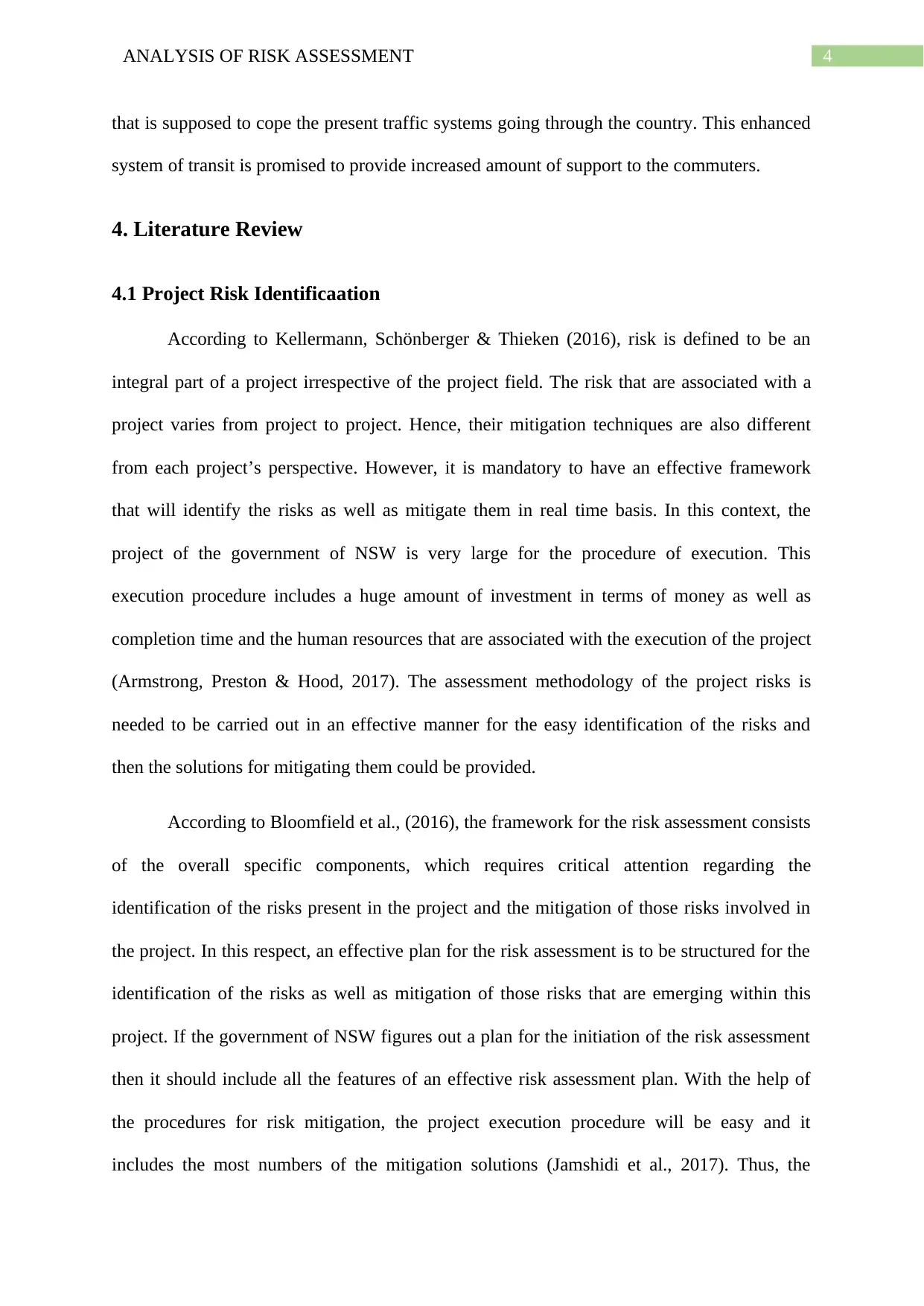
4ANALYSIS OF RISK ASSESSMENT
that is supposed to cope the present traffic systems going through the country. This enhanced
system of transit is promised to provide increased amount of support to the commuters.
4. Literature Review
4.1 Project Risk Identificaation
According to Kellermann, Schönberger & Thieken (2016), risk is defined to be an
integral part of a project irrespective of the project field. The risk that are associated with a
project varies from project to project. Hence, their mitigation techniques are also different
from each project’s perspective. However, it is mandatory to have an effective framework
that will identify the risks as well as mitigate them in real time basis. In this context, the
project of the government of NSW is very large for the procedure of execution. This
execution procedure includes a huge amount of investment in terms of money as well as
completion time and the human resources that are associated with the execution of the project
(Armstrong, Preston & Hood, 2017). The assessment methodology of the project risks is
needed to be carried out in an effective manner for the easy identification of the risks and
then the solutions for mitigating them could be provided.
According to Bloomfield et al., (2016), the framework for the risk assessment consists
of the overall specific components, which requires critical attention regarding the
identification of the risks present in the project and the mitigation of those risks involved in
the project. In this respect, an effective plan for the risk assessment is to be structured for the
identification of the risks as well as mitigation of those risks that are emerging within this
project. If the government of NSW figures out a plan for the initiation of the risk assessment
then it should include all the features of an effective risk assessment plan. With the help of
the procedures for risk mitigation, the project execution procedure will be easy and it
includes the most numbers of the mitigation solutions (Jamshidi et al., 2017). Thus, the
that is supposed to cope the present traffic systems going through the country. This enhanced
system of transit is promised to provide increased amount of support to the commuters.
4. Literature Review
4.1 Project Risk Identificaation
According to Kellermann, Schönberger & Thieken (2016), risk is defined to be an
integral part of a project irrespective of the project field. The risk that are associated with a
project varies from project to project. Hence, their mitigation techniques are also different
from each project’s perspective. However, it is mandatory to have an effective framework
that will identify the risks as well as mitigate them in real time basis. In this context, the
project of the government of NSW is very large for the procedure of execution. This
execution procedure includes a huge amount of investment in terms of money as well as
completion time and the human resources that are associated with the execution of the project
(Armstrong, Preston & Hood, 2017). The assessment methodology of the project risks is
needed to be carried out in an effective manner for the easy identification of the risks and
then the solutions for mitigating them could be provided.
According to Bloomfield et al., (2016), the framework for the risk assessment consists
of the overall specific components, which requires critical attention regarding the
identification of the risks present in the project and the mitigation of those risks involved in
the project. In this respect, an effective plan for the risk assessment is to be structured for the
identification of the risks as well as mitigation of those risks that are emerging within this
project. If the government of NSW figures out a plan for the initiation of the risk assessment
then it should include all the features of an effective risk assessment plan. With the help of
the procedures for risk mitigation, the project execution procedure will be easy and it
includes the most numbers of the mitigation solutions (Jamshidi et al., 2017). Thus, the
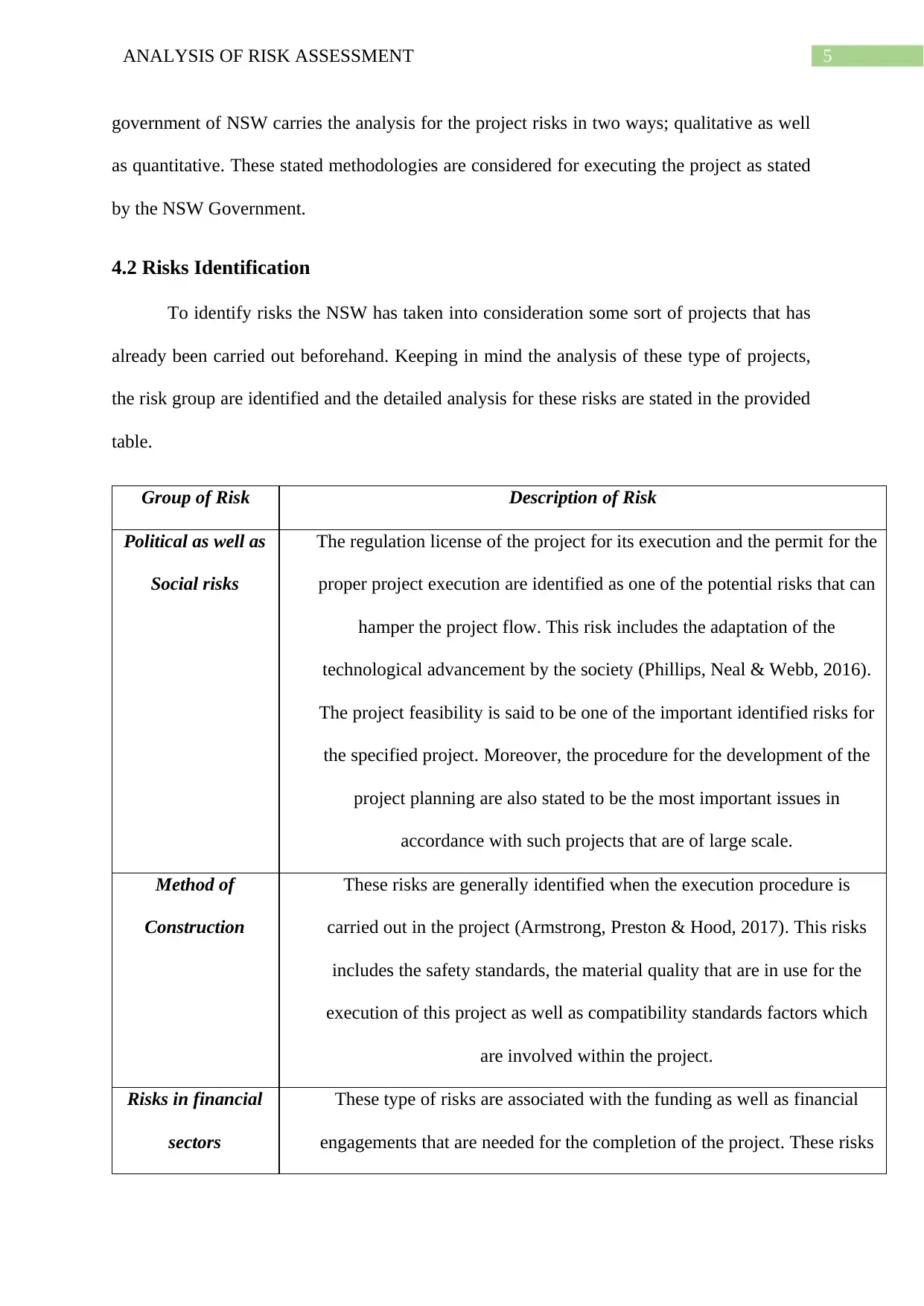
5ANALYSIS OF RISK ASSESSMENT
government of NSW carries the analysis for the project risks in two ways; qualitative as well
as quantitative. These stated methodologies are considered for executing the project as stated
by the NSW Government.
4.2 Risks Identification
To identify risks the NSW has taken into consideration some sort of projects that has
already been carried out beforehand. Keeping in mind the analysis of these type of projects,
the risk group are identified and the detailed analysis for these risks are stated in the provided
table.
Group of Risk Description of Risk
Political as well as
Social risks
The regulation license of the project for its execution and the permit for the
proper project execution are identified as one of the potential risks that can
hamper the project flow. This risk includes the adaptation of the
technological advancement by the society (Phillips, Neal & Webb, 2016).
The project feasibility is said to be one of the important identified risks for
the specified project. Moreover, the procedure for the development of the
project planning are also stated to be the most important issues in
accordance with such projects that are of large scale.
Method of
Construction
These risks are generally identified when the execution procedure is
carried out in the project (Armstrong, Preston & Hood, 2017). This risks
includes the safety standards, the material quality that are in use for the
execution of this project as well as compatibility standards factors which
are involved within the project.
Risks in financial
sectors
These type of risks are associated with the funding as well as financial
engagements that are needed for the completion of the project. These risks
government of NSW carries the analysis for the project risks in two ways; qualitative as well
as quantitative. These stated methodologies are considered for executing the project as stated
by the NSW Government.
4.2 Risks Identification
To identify risks the NSW has taken into consideration some sort of projects that has
already been carried out beforehand. Keeping in mind the analysis of these type of projects,
the risk group are identified and the detailed analysis for these risks are stated in the provided
table.
Group of Risk Description of Risk
Political as well as
Social risks
The regulation license of the project for its execution and the permit for the
proper project execution are identified as one of the potential risks that can
hamper the project flow. This risk includes the adaptation of the
technological advancement by the society (Phillips, Neal & Webb, 2016).
The project feasibility is said to be one of the important identified risks for
the specified project. Moreover, the procedure for the development of the
project planning are also stated to be the most important issues in
accordance with such projects that are of large scale.
Method of
Construction
These risks are generally identified when the execution procedure is
carried out in the project (Armstrong, Preston & Hood, 2017). This risks
includes the safety standards, the material quality that are in use for the
execution of this project as well as compatibility standards factors which
are involved within the project.
Risks in financial
sectors
These type of risks are associated with the funding as well as financial
engagements that are needed for the completion of the project. These risks
⊘ This is a preview!⊘
Do you want full access?
Subscribe today to unlock all pages.

Trusted by 1+ million students worldwide
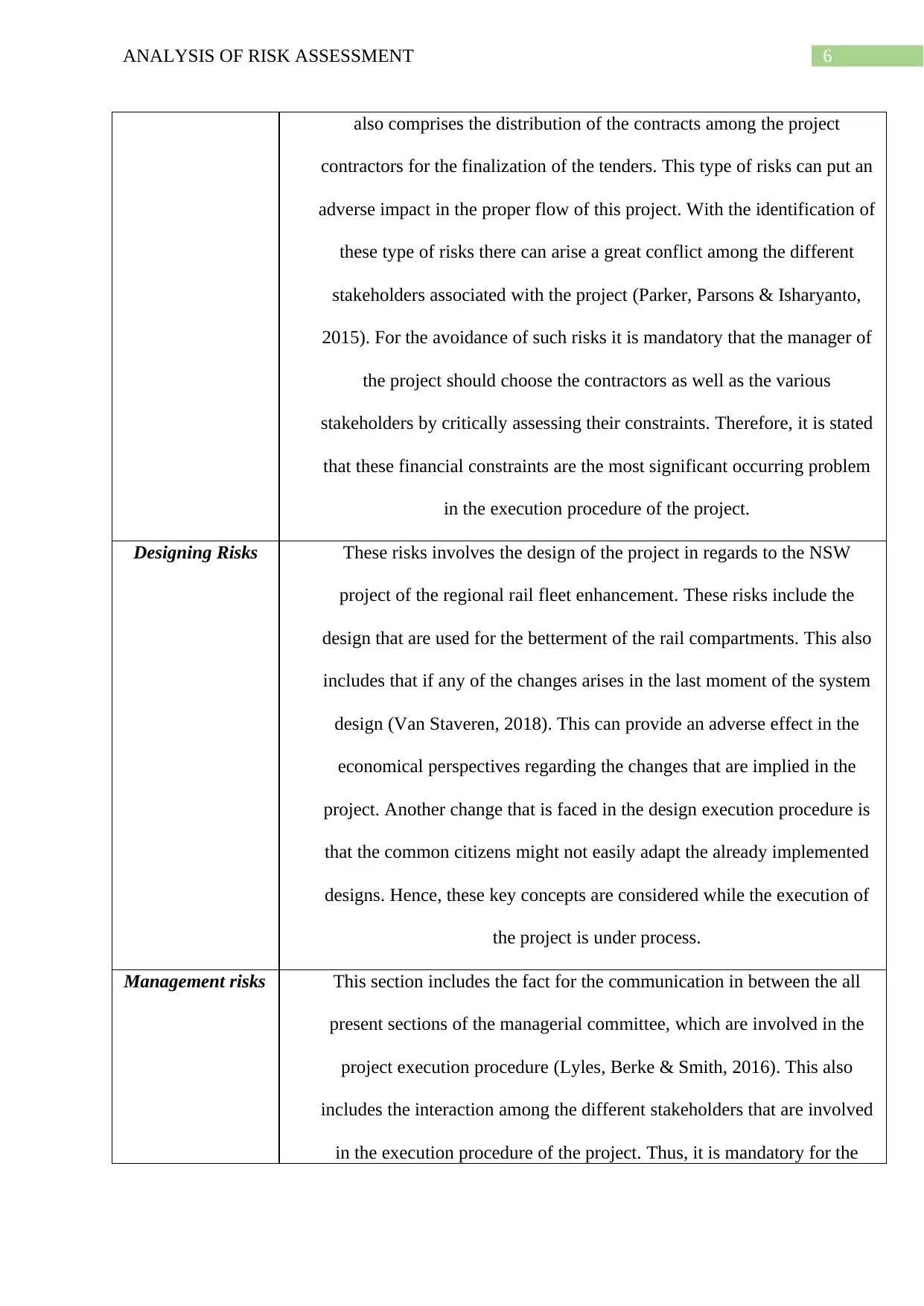
6ANALYSIS OF RISK ASSESSMENT
also comprises the distribution of the contracts among the project
contractors for the finalization of the tenders. This type of risks can put an
adverse impact in the proper flow of this project. With the identification of
these type of risks there can arise a great conflict among the different
stakeholders associated with the project (Parker, Parsons & Isharyanto,
2015). For the avoidance of such risks it is mandatory that the manager of
the project should choose the contractors as well as the various
stakeholders by critically assessing their constraints. Therefore, it is stated
that these financial constraints are the most significant occurring problem
in the execution procedure of the project.
Designing Risks These risks involves the design of the project in regards to the NSW
project of the regional rail fleet enhancement. These risks include the
design that are used for the betterment of the rail compartments. This also
includes that if any of the changes arises in the last moment of the system
design (Van Staveren, 2018). This can provide an adverse effect in the
economical perspectives regarding the changes that are implied in the
project. Another change that is faced in the design execution procedure is
that the common citizens might not easily adapt the already implemented
designs. Hence, these key concepts are considered while the execution of
the project is under process.
Management risks This section includes the fact for the communication in between the all
present sections of the managerial committee, which are involved in the
project execution procedure (Lyles, Berke & Smith, 2016). This also
includes the interaction among the different stakeholders that are involved
in the execution procedure of the project. Thus, it is mandatory for the
also comprises the distribution of the contracts among the project
contractors for the finalization of the tenders. This type of risks can put an
adverse impact in the proper flow of this project. With the identification of
these type of risks there can arise a great conflict among the different
stakeholders associated with the project (Parker, Parsons & Isharyanto,
2015). For the avoidance of such risks it is mandatory that the manager of
the project should choose the contractors as well as the various
stakeholders by critically assessing their constraints. Therefore, it is stated
that these financial constraints are the most significant occurring problem
in the execution procedure of the project.
Designing Risks These risks involves the design of the project in regards to the NSW
project of the regional rail fleet enhancement. These risks include the
design that are used for the betterment of the rail compartments. This also
includes that if any of the changes arises in the last moment of the system
design (Van Staveren, 2018). This can provide an adverse effect in the
economical perspectives regarding the changes that are implied in the
project. Another change that is faced in the design execution procedure is
that the common citizens might not easily adapt the already implemented
designs. Hence, these key concepts are considered while the execution of
the project is under process.
Management risks This section includes the fact for the communication in between the all
present sections of the managerial committee, which are involved in the
project execution procedure (Lyles, Berke & Smith, 2016). This also
includes the interaction among the different stakeholders that are involved
in the execution procedure of the project. Thus, it is mandatory for the
Paraphrase This Document
Need a fresh take? Get an instant paraphrase of this document with our AI Paraphraser
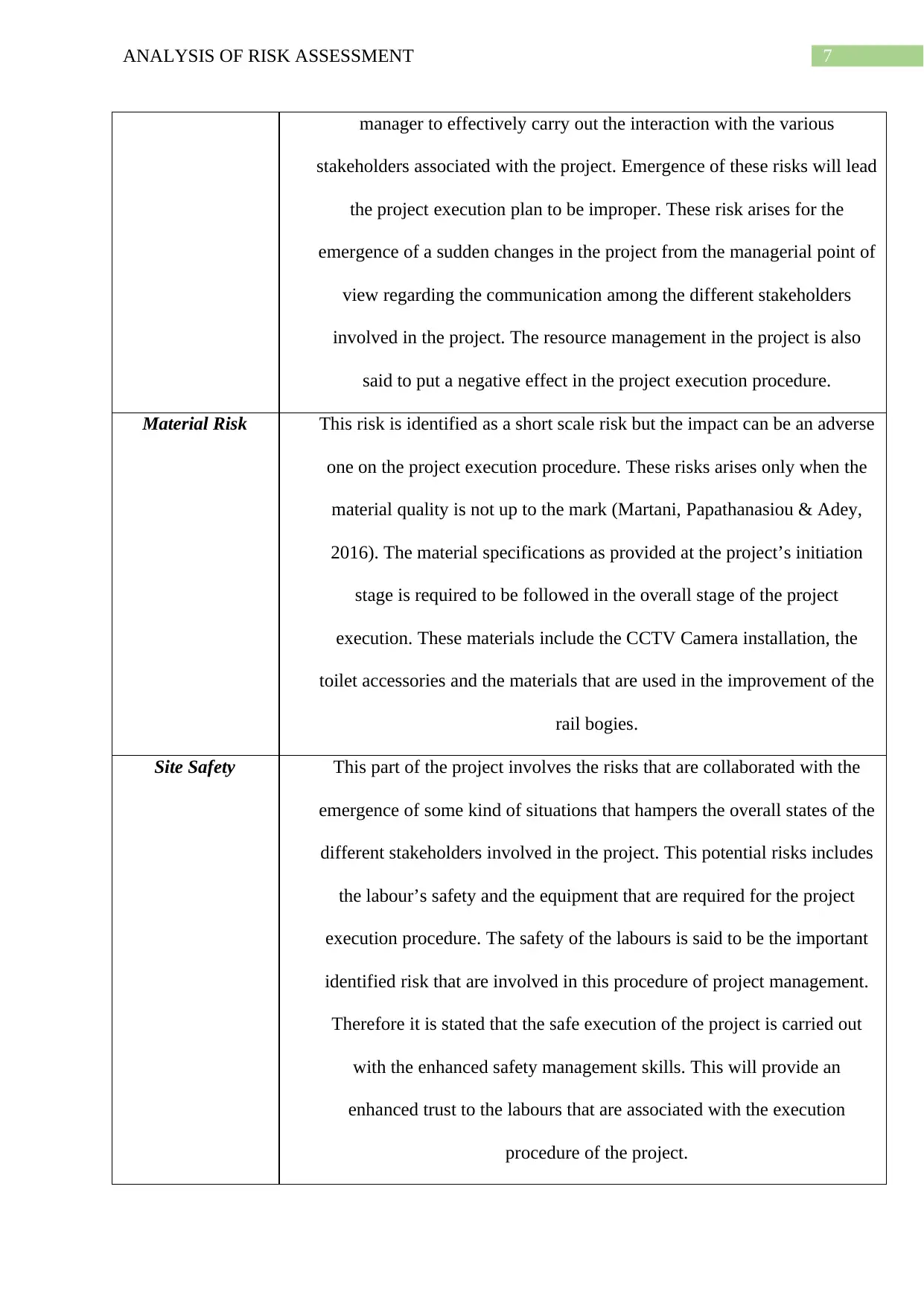
7ANALYSIS OF RISK ASSESSMENT
manager to effectively carry out the interaction with the various
stakeholders associated with the project. Emergence of these risks will lead
the project execution plan to be improper. These risk arises for the
emergence of a sudden changes in the project from the managerial point of
view regarding the communication among the different stakeholders
involved in the project. The resource management in the project is also
said to put a negative effect in the project execution procedure.
Material Risk This risk is identified as a short scale risk but the impact can be an adverse
one on the project execution procedure. These risks arises only when the
material quality is not up to the mark (Martani, Papathanasiou & Adey,
2016). The material specifications as provided at the project’s initiation
stage is required to be followed in the overall stage of the project
execution. These materials include the CCTV Camera installation, the
toilet accessories and the materials that are used in the improvement of the
rail bogies.
Site Safety This part of the project involves the risks that are collaborated with the
emergence of some kind of situations that hampers the overall states of the
different stakeholders involved in the project. This potential risks includes
the labour’s safety and the equipment that are required for the project
execution procedure. The safety of the labours is said to be the important
identified risk that are involved in this procedure of project management.
Therefore it is stated that the safe execution of the project is carried out
with the enhanced safety management skills. This will provide an
enhanced trust to the labours that are associated with the execution
procedure of the project.
manager to effectively carry out the interaction with the various
stakeholders associated with the project. Emergence of these risks will lead
the project execution plan to be improper. These risk arises for the
emergence of a sudden changes in the project from the managerial point of
view regarding the communication among the different stakeholders
involved in the project. The resource management in the project is also
said to put a negative effect in the project execution procedure.
Material Risk This risk is identified as a short scale risk but the impact can be an adverse
one on the project execution procedure. These risks arises only when the
material quality is not up to the mark (Martani, Papathanasiou & Adey,
2016). The material specifications as provided at the project’s initiation
stage is required to be followed in the overall stage of the project
execution. These materials include the CCTV Camera installation, the
toilet accessories and the materials that are used in the improvement of the
rail bogies.
Site Safety This part of the project involves the risks that are collaborated with the
emergence of some kind of situations that hampers the overall states of the
different stakeholders involved in the project. This potential risks includes
the labour’s safety and the equipment that are required for the project
execution procedure. The safety of the labours is said to be the important
identified risk that are involved in this procedure of project management.
Therefore it is stated that the safe execution of the project is carried out
with the enhanced safety management skills. This will provide an
enhanced trust to the labours that are associated with the execution
procedure of the project.
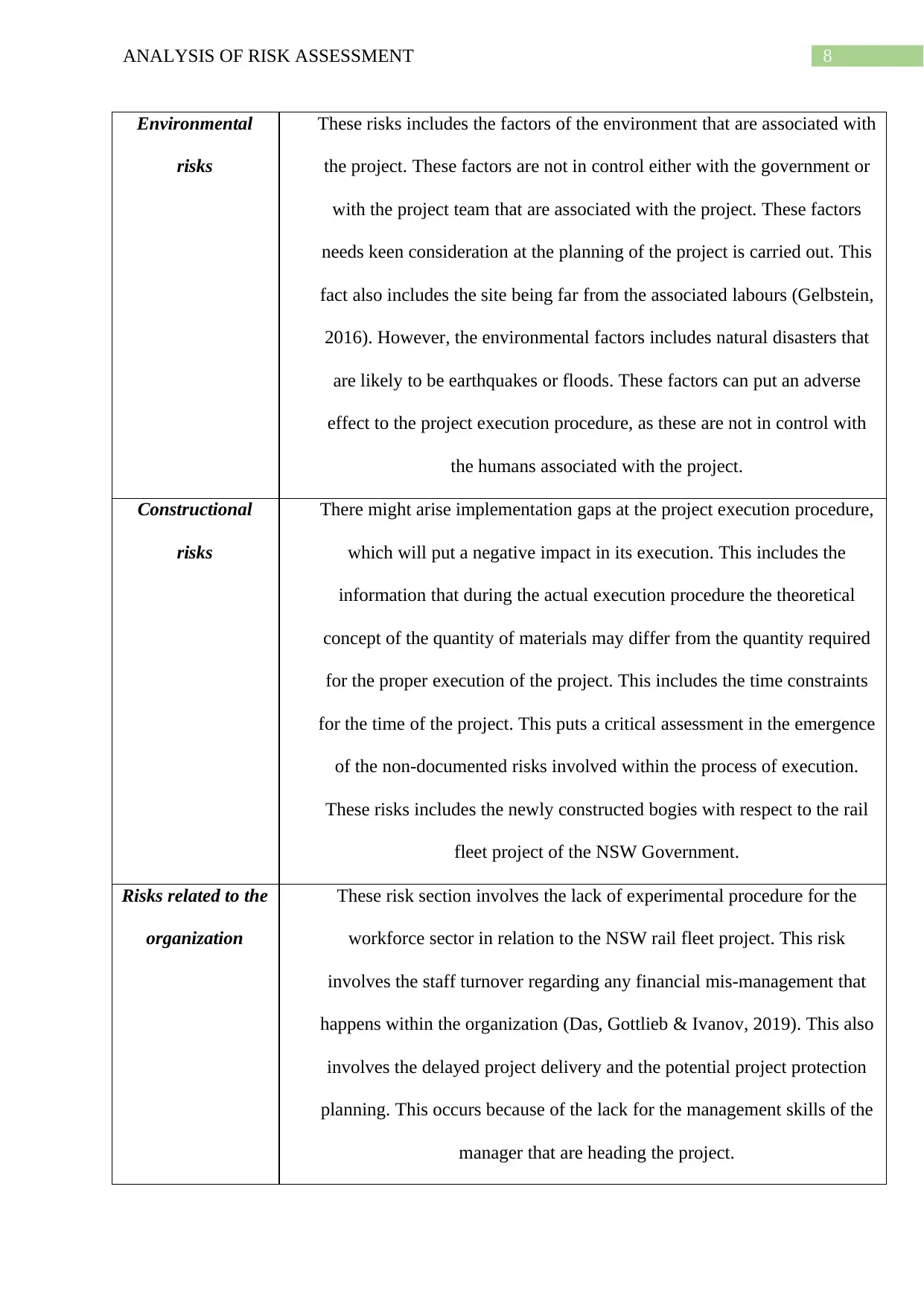
8ANALYSIS OF RISK ASSESSMENT
Environmental
risks
These risks includes the factors of the environment that are associated with
the project. These factors are not in control either with the government or
with the project team that are associated with the project. These factors
needs keen consideration at the planning of the project is carried out. This
fact also includes the site being far from the associated labours (Gelbstein,
2016). However, the environmental factors includes natural disasters that
are likely to be earthquakes or floods. These factors can put an adverse
effect to the project execution procedure, as these are not in control with
the humans associated with the project.
Constructional
risks
There might arise implementation gaps at the project execution procedure,
which will put a negative impact in its execution. This includes the
information that during the actual execution procedure the theoretical
concept of the quantity of materials may differ from the quantity required
for the proper execution of the project. This includes the time constraints
for the time of the project. This puts a critical assessment in the emergence
of the non-documented risks involved within the process of execution.
These risks includes the newly constructed bogies with respect to the rail
fleet project of the NSW Government.
Risks related to the
organization
These risk section involves the lack of experimental procedure for the
workforce sector in relation to the NSW rail fleet project. This risk
involves the staff turnover regarding any financial mis-management that
happens within the organization (Das, Gottlieb & Ivanov, 2019). This also
involves the delayed project delivery and the potential project protection
planning. This occurs because of the lack for the management skills of the
manager that are heading the project.
Environmental
risks
These risks includes the factors of the environment that are associated with
the project. These factors are not in control either with the government or
with the project team that are associated with the project. These factors
needs keen consideration at the planning of the project is carried out. This
fact also includes the site being far from the associated labours (Gelbstein,
2016). However, the environmental factors includes natural disasters that
are likely to be earthquakes or floods. These factors can put an adverse
effect to the project execution procedure, as these are not in control with
the humans associated with the project.
Constructional
risks
There might arise implementation gaps at the project execution procedure,
which will put a negative impact in its execution. This includes the
information that during the actual execution procedure the theoretical
concept of the quantity of materials may differ from the quantity required
for the proper execution of the project. This includes the time constraints
for the time of the project. This puts a critical assessment in the emergence
of the non-documented risks involved within the process of execution.
These risks includes the newly constructed bogies with respect to the rail
fleet project of the NSW Government.
Risks related to the
organization
These risk section involves the lack of experimental procedure for the
workforce sector in relation to the NSW rail fleet project. This risk
involves the staff turnover regarding any financial mis-management that
happens within the organization (Das, Gottlieb & Ivanov, 2019). This also
involves the delayed project delivery and the potential project protection
planning. This occurs because of the lack for the management skills of the
manager that are heading the project.
⊘ This is a preview!⊘
Do you want full access?
Subscribe today to unlock all pages.

Trusted by 1+ million students worldwide
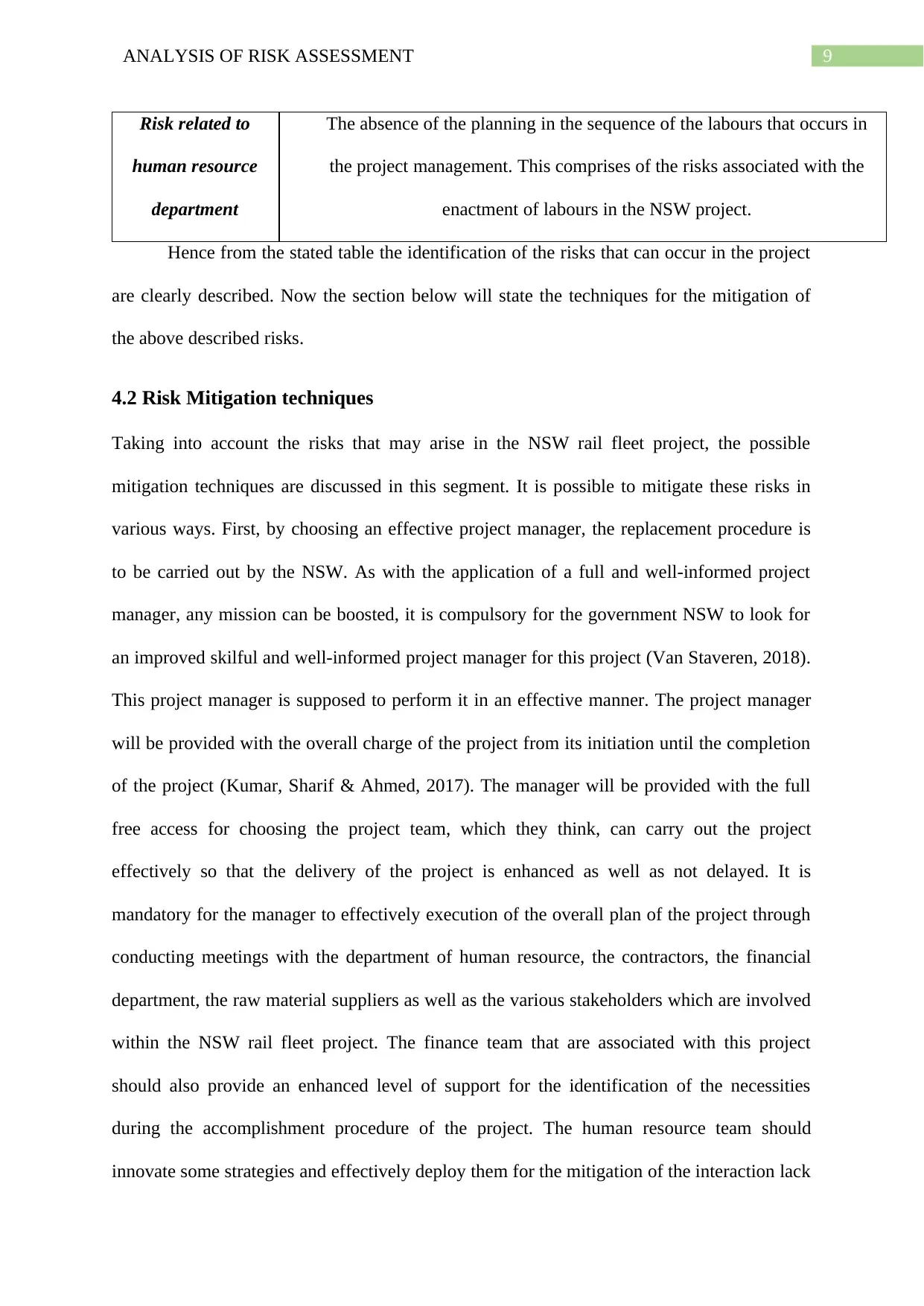
9ANALYSIS OF RISK ASSESSMENT
Risk related to
human resource
department
The absence of the planning in the sequence of the labours that occurs in
the project management. This comprises of the risks associated with the
enactment of labours in the NSW project.
Hence from the stated table the identification of the risks that can occur in the project
are clearly described. Now the section below will state the techniques for the mitigation of
the above described risks.
4.2 Risk Mitigation techniques
Taking into account the risks that may arise in the NSW rail fleet project, the possible
mitigation techniques are discussed in this segment. It is possible to mitigate these risks in
various ways. First, by choosing an effective project manager, the replacement procedure is
to be carried out by the NSW. As with the application of a full and well-informed project
manager, any mission can be boosted, it is compulsory for the government NSW to look for
an improved skilful and well-informed project manager for this project (Van Staveren, 2018).
This project manager is supposed to perform it in an effective manner. The project manager
will be provided with the overall charge of the project from its initiation until the completion
of the project (Kumar, Sharif & Ahmed, 2017). The manager will be provided with the full
free access for choosing the project team, which they think, can carry out the project
effectively so that the delivery of the project is enhanced as well as not delayed. It is
mandatory for the manager to effectively execution of the overall plan of the project through
conducting meetings with the department of human resource, the contractors, the financial
department, the raw material suppliers as well as the various stakeholders which are involved
within the NSW rail fleet project. The finance team that are associated with this project
should also provide an enhanced level of support for the identification of the necessities
during the accomplishment procedure of the project. The human resource team should
innovate some strategies and effectively deploy them for the mitigation of the interaction lack
Risk related to
human resource
department
The absence of the planning in the sequence of the labours that occurs in
the project management. This comprises of the risks associated with the
enactment of labours in the NSW project.
Hence from the stated table the identification of the risks that can occur in the project
are clearly described. Now the section below will state the techniques for the mitigation of
the above described risks.
4.2 Risk Mitigation techniques
Taking into account the risks that may arise in the NSW rail fleet project, the possible
mitigation techniques are discussed in this segment. It is possible to mitigate these risks in
various ways. First, by choosing an effective project manager, the replacement procedure is
to be carried out by the NSW. As with the application of a full and well-informed project
manager, any mission can be boosted, it is compulsory for the government NSW to look for
an improved skilful and well-informed project manager for this project (Van Staveren, 2018).
This project manager is supposed to perform it in an effective manner. The project manager
will be provided with the overall charge of the project from its initiation until the completion
of the project (Kumar, Sharif & Ahmed, 2017). The manager will be provided with the full
free access for choosing the project team, which they think, can carry out the project
effectively so that the delivery of the project is enhanced as well as not delayed. It is
mandatory for the manager to effectively execution of the overall plan of the project through
conducting meetings with the department of human resource, the contractors, the financial
department, the raw material suppliers as well as the various stakeholders which are involved
within the NSW rail fleet project. The finance team that are associated with this project
should also provide an enhanced level of support for the identification of the necessities
during the accomplishment procedure of the project. The human resource team should
innovate some strategies and effectively deploy them for the mitigation of the interaction lack
Paraphrase This Document
Need a fresh take? Get an instant paraphrase of this document with our AI Paraphraser
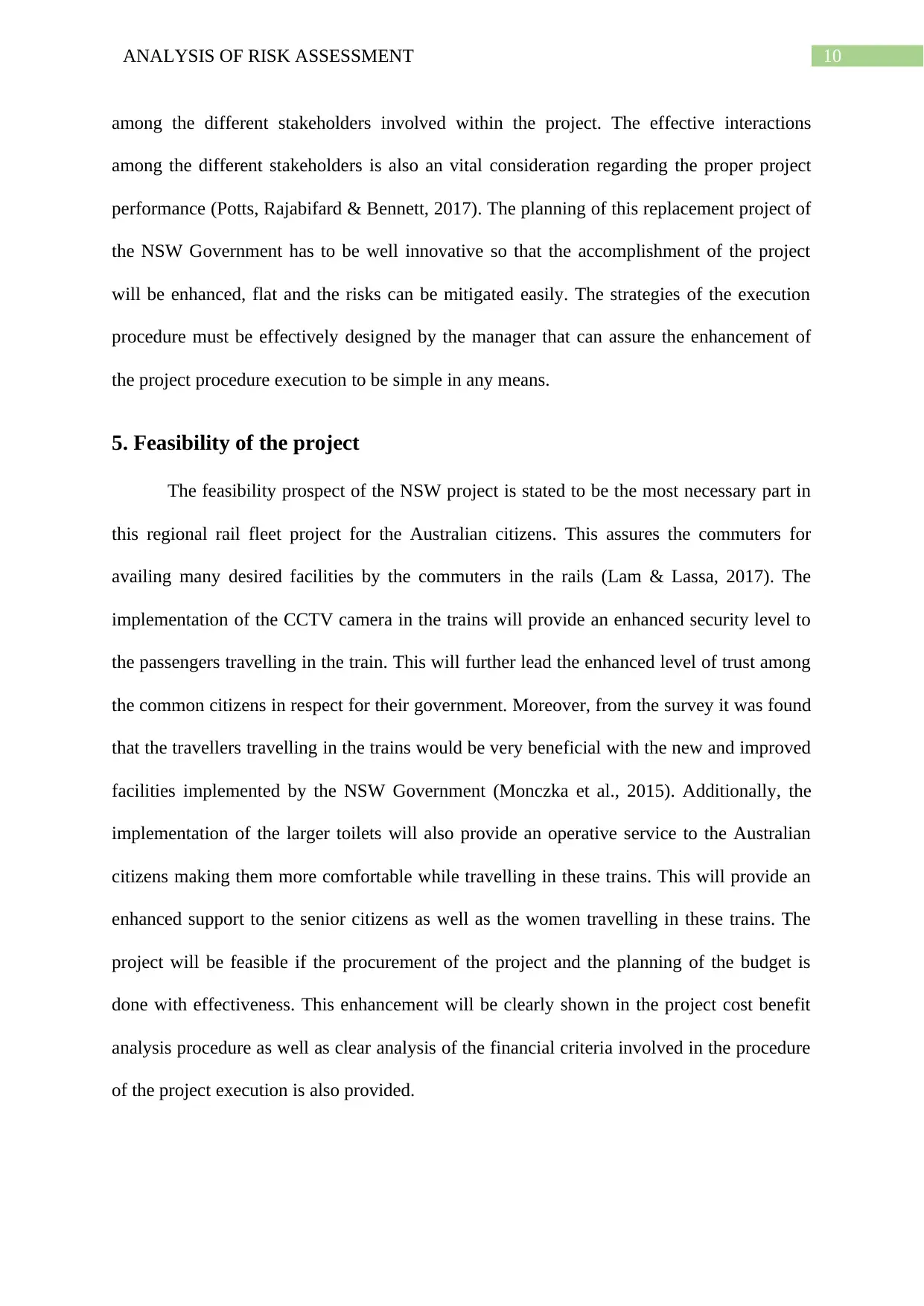
10ANALYSIS OF RISK ASSESSMENT
among the different stakeholders involved within the project. The effective interactions
among the different stakeholders is also an vital consideration regarding the proper project
performance (Potts, Rajabifard & Bennett, 2017). The planning of this replacement project of
the NSW Government has to be well innovative so that the accomplishment of the project
will be enhanced, flat and the risks can be mitigated easily. The strategies of the execution
procedure must be effectively designed by the manager that can assure the enhancement of
the project procedure execution to be simple in any means.
5. Feasibility of the project
The feasibility prospect of the NSW project is stated to be the most necessary part in
this regional rail fleet project for the Australian citizens. This assures the commuters for
availing many desired facilities by the commuters in the rails (Lam & Lassa, 2017). The
implementation of the CCTV camera in the trains will provide an enhanced security level to
the passengers travelling in the train. This will further lead the enhanced level of trust among
the common citizens in respect for their government. Moreover, from the survey it was found
that the travellers travelling in the trains would be very beneficial with the new and improved
facilities implemented by the NSW Government (Monczka et al., 2015). Additionally, the
implementation of the larger toilets will also provide an operative service to the Australian
citizens making them more comfortable while travelling in these trains. This will provide an
enhanced support to the senior citizens as well as the women travelling in these trains. The
project will be feasible if the procurement of the project and the planning of the budget is
done with effectiveness. This enhancement will be clearly shown in the project cost benefit
analysis procedure as well as clear analysis of the financial criteria involved in the procedure
of the project execution is also provided.
among the different stakeholders involved within the project. The effective interactions
among the different stakeholders is also an vital consideration regarding the proper project
performance (Potts, Rajabifard & Bennett, 2017). The planning of this replacement project of
the NSW Government has to be well innovative so that the accomplishment of the project
will be enhanced, flat and the risks can be mitigated easily. The strategies of the execution
procedure must be effectively designed by the manager that can assure the enhancement of
the project procedure execution to be simple in any means.
5. Feasibility of the project
The feasibility prospect of the NSW project is stated to be the most necessary part in
this regional rail fleet project for the Australian citizens. This assures the commuters for
availing many desired facilities by the commuters in the rails (Lam & Lassa, 2017). The
implementation of the CCTV camera in the trains will provide an enhanced security level to
the passengers travelling in the train. This will further lead the enhanced level of trust among
the common citizens in respect for their government. Moreover, from the survey it was found
that the travellers travelling in the trains would be very beneficial with the new and improved
facilities implemented by the NSW Government (Monczka et al., 2015). Additionally, the
implementation of the larger toilets will also provide an operative service to the Australian
citizens making them more comfortable while travelling in these trains. This will provide an
enhanced support to the senior citizens as well as the women travelling in these trains. The
project will be feasible if the procurement of the project and the planning of the budget is
done with effectiveness. This enhancement will be clearly shown in the project cost benefit
analysis procedure as well as clear analysis of the financial criteria involved in the procedure
of the project execution is also provided.
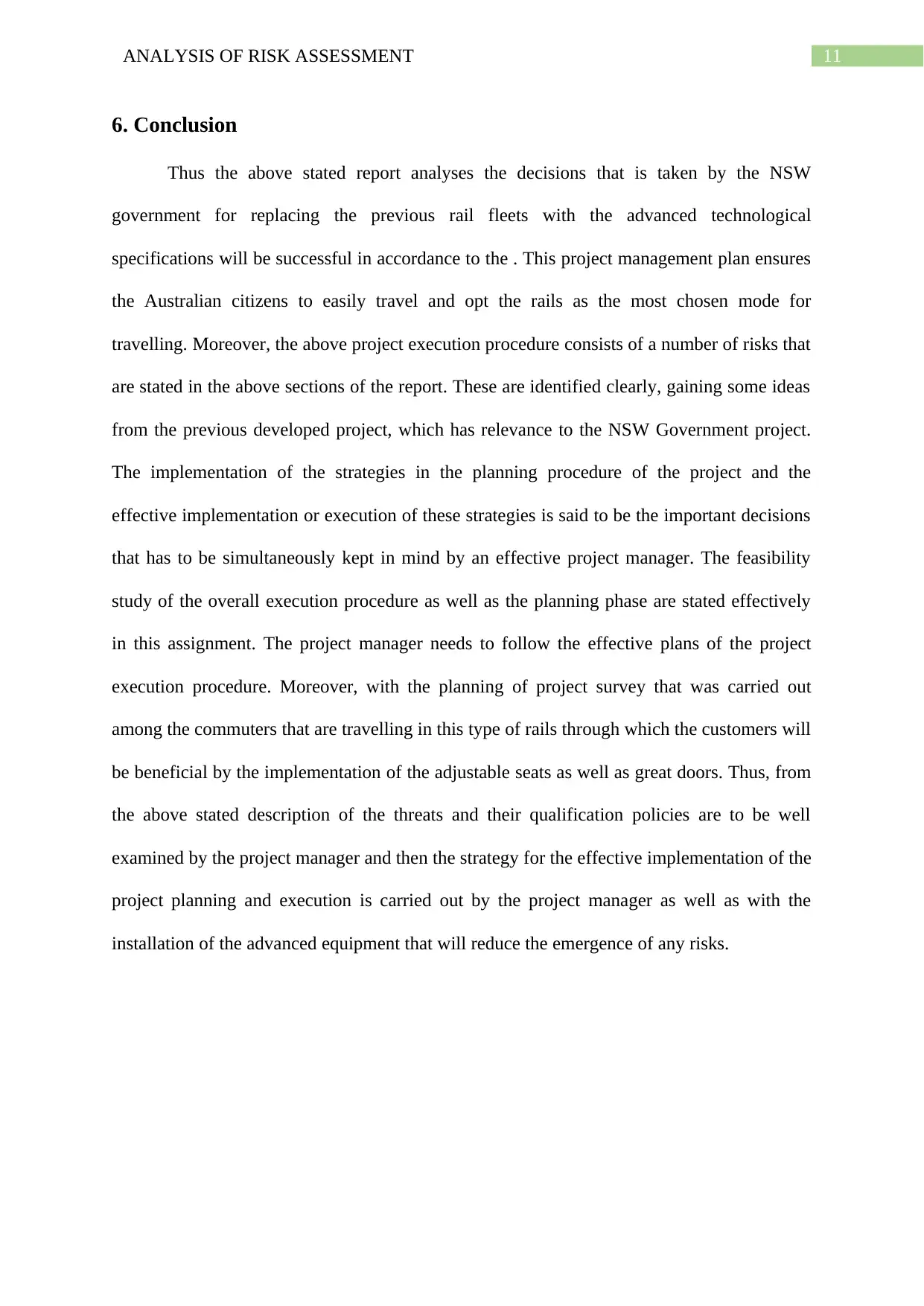
11ANALYSIS OF RISK ASSESSMENT
6. Conclusion
Thus the above stated report analyses the decisions that is taken by the NSW
government for replacing the previous rail fleets with the advanced technological
specifications will be successful in accordance to the . This project management plan ensures
the Australian citizens to easily travel and opt the rails as the most chosen mode for
travelling. Moreover, the above project execution procedure consists of a number of risks that
are stated in the above sections of the report. These are identified clearly, gaining some ideas
from the previous developed project, which has relevance to the NSW Government project.
The implementation of the strategies in the planning procedure of the project and the
effective implementation or execution of these strategies is said to be the important decisions
that has to be simultaneously kept in mind by an effective project manager. The feasibility
study of the overall execution procedure as well as the planning phase are stated effectively
in this assignment. The project manager needs to follow the effective plans of the project
execution procedure. Moreover, with the planning of project survey that was carried out
among the commuters that are travelling in this type of rails through which the customers will
be beneficial by the implementation of the adjustable seats as well as great doors. Thus, from
the above stated description of the threats and their qualification policies are to be well
examined by the project manager and then the strategy for the effective implementation of the
project planning and execution is carried out by the project manager as well as with the
installation of the advanced equipment that will reduce the emergence of any risks.
6. Conclusion
Thus the above stated report analyses the decisions that is taken by the NSW
government for replacing the previous rail fleets with the advanced technological
specifications will be successful in accordance to the . This project management plan ensures
the Australian citizens to easily travel and opt the rails as the most chosen mode for
travelling. Moreover, the above project execution procedure consists of a number of risks that
are stated in the above sections of the report. These are identified clearly, gaining some ideas
from the previous developed project, which has relevance to the NSW Government project.
The implementation of the strategies in the planning procedure of the project and the
effective implementation or execution of these strategies is said to be the important decisions
that has to be simultaneously kept in mind by an effective project manager. The feasibility
study of the overall execution procedure as well as the planning phase are stated effectively
in this assignment. The project manager needs to follow the effective plans of the project
execution procedure. Moreover, with the planning of project survey that was carried out
among the commuters that are travelling in this type of rails through which the customers will
be beneficial by the implementation of the adjustable seats as well as great doors. Thus, from
the above stated description of the threats and their qualification policies are to be well
examined by the project manager and then the strategy for the effective implementation of the
project planning and execution is carried out by the project manager as well as with the
installation of the advanced equipment that will reduce the emergence of any risks.
⊘ This is a preview!⊘
Do you want full access?
Subscribe today to unlock all pages.

Trusted by 1+ million students worldwide
1 out of 15
Related Documents
Your All-in-One AI-Powered Toolkit for Academic Success.
+13062052269
info@desklib.com
Available 24*7 on WhatsApp / Email
![[object Object]](/_next/static/media/star-bottom.7253800d.svg)
Unlock your academic potential
Copyright © 2020–2025 A2Z Services. All Rights Reserved. Developed and managed by ZUCOL.





